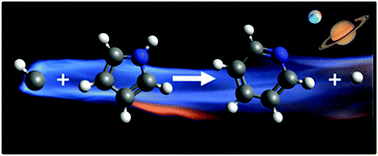Direct detection ofpyridine formation by the reaction of CH (CD) with pyrrole: a ring expansion reaction
Abstract
The reaction of the ground state

* Corresponding authors
a
Departments of Chemistry and Physics, University of California, Berkeley, USA
E-mail:
srl@berkeley.edu, ssoorkia@berkley.edu
b Combustion Research Facility, Mail Stop 9055, Sandia National Laboratories, Livermore, USA
c Department of Chemistry, University of Wisconsin-Washington County, West Bend, USA
d School of Chemistry, University of Wollongong, New South Wales, Australia
e Chemical Sciences Division, Lawrence Berkeley National Laboratory, 1 Cyclotron Road, Berkeley, USA
The reaction of the ground state

 Please wait while we load your content...
Something went wrong. Try again?
Please wait while we load your content...
Something went wrong. Try again?
S. Soorkia, C. A. Taatjes, D. L. Osborn, T. M. Selby, A. J. Trevitt, K. R. Wilson and S. R. Leone, Phys. Chem. Chem. Phys., 2010, 12, 8750 DOI: 10.1039/C002135K
To request permission to reproduce material from this article, please go to the Copyright Clearance Center request page.
If you are an author contributing to an RSC publication, you do not need to request permission provided correct acknowledgement is given.
If you are the author of this article, you do not need to request permission to reproduce figures and diagrams provided correct acknowledgement is given. If you want to reproduce the whole article in a third-party publication (excluding your thesis/dissertation for which permission is not required) please go to the Copyright Clearance Center request page.
Read more about how to correctly acknowledge RSC content.
 Fetching data from CrossRef.
Fetching data from CrossRef.
This may take some time to load.
Loading related content
